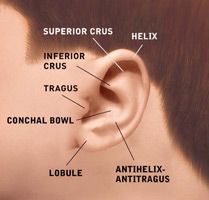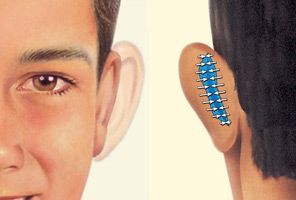
What is ear surgery?
Ear surgery, also known as otoplasty, can improve the shape, position or proportion of the ear. A defect in the ear structure that is present at birth or that becomes apparent with development can be corrected by otoplasty. This procedure can also treat misshapen ears caused by an injury.
Otoplasty creates a more natural shape while bringing balance and proportion to the ears and face. Correction of even minor deformities can have profound benefits to appearance and self-esteem. If protruding or disfigured ears bother you or your child, you may consider plastic surgery.
What can ear surgery treat?
- Overly large ears – a condition called macrotia
- Protruding ears occurring on one or both sides in varying degrees – not associated with hearing loss
- Adult dissatisfaction with previous ear surgery
Who is a good candidate for ear surgery?
Children who are good candidates for ear surgery are:
- Healthy, without a life-threatening illness or untreated chronic ear infections
- Generally 5 years old, or when a child's ear cartilage is stable enough for correction
- Cooperative and follow instructions well
- Able to communicate their feelings and do not voice objections when surgery is discussed
Teenagers and adults who are good candidates for ear surgery are:
- Healthy individuals who do not have a life-threatening illness or medical conditions that can impair healing
- Individuals with a positive outlook and specific goals in mind for ear surgery
- Nonsmokers
Ear surgery is a highly individualized procedure and you should do it for yourself, not to fulfill someone else's desires or to try to fit any sort of ideal image.
What are the steps of an ear surgery procedure?
Step 1 – Anesthesia
Medications are administered for your comfort during the surgical procedure. The choices include local, intravenous sedation or general anesthesia. Your doctor will recommend the best choice for you.
Step 2 – The incision
Correction of protruding ears uses surgical techniques to create or increase the antihelical fold (just inside the rim of the ear) and to reduce enlarged conchal cartilage (the largest and deepest concavity of the external ear). Incisions for otoplasty are generally made on the back surface of the ear. When incisions are necessary on the front of the ear, they are made within its folds to hide them. Internal, nonremovable sutures are used to create and secure the newly shaped cartilage in place.


Step 3 – Closing the incisions
External stitches close the incision. Techniques are individualized, taking care not to distort other structures and to avoid an unnatural "pinned back" appearance.

Step 4 – See the results
Ear surgery offers near immediate results in cases of protruding ears, visible once the dressings that support the new shape of the ear during initial phases of healing are removed. With the ear permanently positioned closer to the head, surgical scars are either hidden behind the ear or well hidden within the natural creases of the ear.










